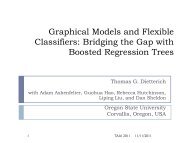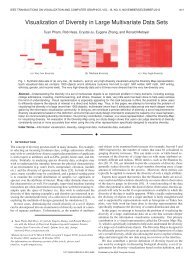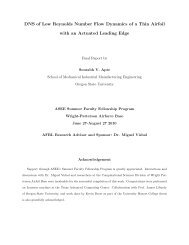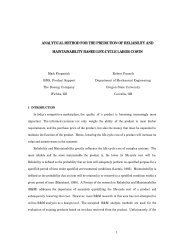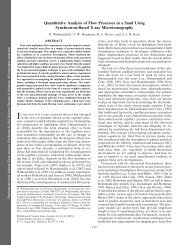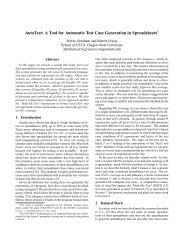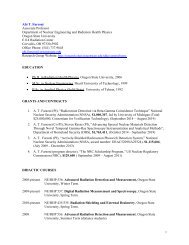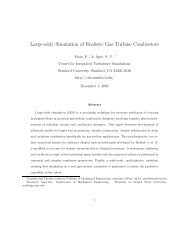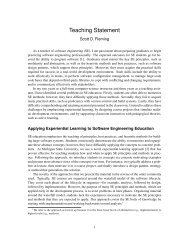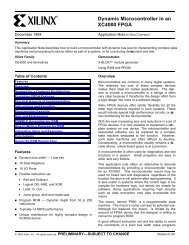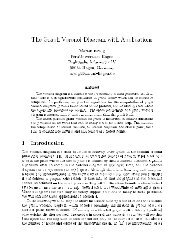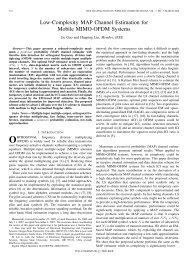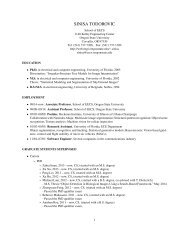ILASS Americas 20th Annual Conference on Liquid Atomization and ...
ILASS Americas 20th Annual Conference on Liquid Atomization and ...
ILASS Americas 20th Annual Conference on Liquid Atomization and ...
You also want an ePaper? Increase the reach of your titles
YUMPU automatically turns print PDFs into web optimized ePapers that Google loves.
Introducti<strong>on</strong><br />
Majority of spray systems in propulsi<strong>on</strong> applicati<strong>on</strong>s<br />
involve complex geometries <strong>and</strong> highly<br />
unsteady, turbulent flows near the injector. The<br />
numerical models for spray calculati<strong>on</strong>s should be<br />
able to accurately represent droplet deformati<strong>on</strong>,<br />
breakup, collisi<strong>on</strong>/coalescence, <strong>and</strong> dispersi<strong>on</strong> due<br />
to turbulence. In the traditi<strong>on</strong>al approach for spray<br />
computati<strong>on</strong>, the Eulerian equati<strong>on</strong>s for gaseous<br />
phase are solved al<strong>on</strong>g with a Lagrangian model for<br />
particle transport with two-way coupling of mass,<br />
momentum, <strong>and</strong> energy exchange between the two<br />
phases [1]. Typically simulati<strong>on</strong>s of spray systems<br />
use DNS, LES or RANS for the carrier phase<br />
whereas the moti<strong>on</strong> of the dispersed phase is modeled.<br />
The ‘point-particle’ (PP) assumpti<strong>on</strong> is comm<strong>on</strong>ly<br />
employed where forces <strong>on</strong> the dispersed phase<br />
are computed through model coefficients. The effect<br />
of the particles 1 <strong>on</strong> the carrier phase is represented<br />
by a force applied at the centroid of the particle.<br />
The disperse phase equati<strong>on</strong>s are typically solved in<br />
a Lagrangian frame by tracking a few set of computati<strong>on</strong>al<br />
particles or parcels [2] with models for<br />
droplet breakup, collisi<strong>on</strong>/coalescence, evaporati<strong>on</strong>,<br />
dispersi<strong>on</strong>, <strong>and</strong> deformati<strong>on</strong>. Fully resolved simulati<strong>on</strong>s<br />
involving comprehensive modeling of interfacial<br />
dynamics are being developed [3, 4], however,<br />
are computati<strong>on</strong>ally expensive.<br />
Several simulati<strong>on</strong>s of particle-laden flows have<br />
been performed with the carrier fluid simulated using<br />
direct numerical simulati<strong>on</strong> ([5, 6],[7],[8]), largeeddy<br />
simulati<strong>on</strong> ([9, 10, 11, 12]), or Reynoldsaveraged<br />
Navier Stokes equati<strong>on</strong>s [13], where the dispersed<br />
phase is assumed subgrid (so d p < L K , the<br />
Kolmogorov length scale, for DNS whereas d p < ∆,<br />
the grid size, in LES or RANS). However, modeling<br />
the dispersed phase using point-particle approach<br />
does not always provide the correct results. For<br />
moderate loadings <strong>and</strong> wall-bounded flows [11] have<br />
shown that the point-particle approximati<strong>on</strong> fails to<br />
predict the turbulence modulati<strong>on</strong> compared to experimental<br />
values. In additi<strong>on</strong>, if the particle size<br />
is comparable to the Kolmogorov scale (for DNS)<br />
or the grid size (for LES/RANS), simple drag/lift<br />
laws typically employed in PP do not capture the<br />
unsteady wake effects comm<strong>on</strong>ly observed in full<br />
DNS studies ([14, 15]). These effects become even<br />
more pr<strong>on</strong>ounced in dense particulate regi<strong>on</strong>s. In<br />
many practical applicati<strong>on</strong>s, the local particle size<br />
<strong>and</strong> c<strong>on</strong>centrati<strong>on</strong>s may vary substantially. In liquid<br />
atomizati<strong>on</strong> process, e.g., the droplet sizes may<br />
range from 1 mm to 1 µm with dense regi<strong>on</strong>s near<br />
the injector nozzle. The point-particle assumpti<strong>on</strong><br />
is invalid under these c<strong>on</strong>diti<strong>on</strong>s.<br />
In the present work, we extend the point-particle<br />
approach by accounting for the volumetric displacements<br />
of the carried phase due to the moti<strong>on</strong> of particles<br />
or droplets. The disperse phase also affects the<br />
carrier phase through mass, momentum, <strong>and</strong> energy<br />
coupling. The combined effect is termed as ‘volumetric<br />
coupling’. This approach is based <strong>on</strong> the the<br />
original formulati<strong>on</strong> by Duckowicz [1] <strong>and</strong> later modified<br />
by Joseph & Lundgren [16]. The approach is<br />
derived based <strong>on</strong> mixture theory that account for<br />
the droplet (or particle) volume fracti<strong>on</strong> in a given<br />
computati<strong>on</strong>al cell. This effect is important in dense<br />
spray regimes, however, are typically ignored in the<br />
c<strong>on</strong>text of LES or DNS simulati<strong>on</strong>s [17, 12]. A similar<br />
formulati<strong>on</strong> has been applied to bubbly flows at<br />
low bubble c<strong>on</strong>centrati<strong>on</strong>s (up to 0.02) to investigate<br />
the effect of bubbles <strong>on</strong> drag reducti<strong>on</strong> in turbulent<br />
flows [8, 18]. Several studies <strong>on</strong> laminar dense granular<br />
flows [19, 20, 21] also use this approach. Recently,<br />
Apte etal. [22] have shown the effect of volumetric<br />
displacements <strong>on</strong> the carrier fluid in dense<br />
particle-laden flows. They compared the soluti<strong>on</strong>s<br />
for the carrier phase <strong>and</strong> the particle dispersi<strong>on</strong> obtained<br />
from the point-particle assumpti<strong>on</strong> <strong>and</strong> accounting<br />
for volumetric displacements to show large<br />
differences. If the volume displaced by the disperse<br />
phase is taken into account, thte velocity field is no<br />
l<strong>on</strong>ger divergence free in the regi<strong>on</strong>s of variati<strong>on</strong>s<br />
in volume fracti<strong>on</strong>s. This has a direct effect <strong>on</strong> the<br />
pressure Poiss<strong>on</strong> equati<strong>on</strong>, altering the pressure field<br />
through a local source term. These effects may become<br />
important in dense regi<strong>on</strong>s of spray system.<br />
However, computing dense spray systems by accounting<br />
for volume displacements due to droplet<br />
moti<strong>on</strong> could be numerically challenging. The temporal<br />
<strong>and</strong> spatial variati<strong>on</strong>s in fluid volume fracti<strong>on</strong>s<br />
could be locally large <strong>and</strong> make the computati<strong>on</strong> numerically<br />
unstable. This is specifically true if the interphase<br />
coupling of mass, momentum, <strong>and</strong> energy<br />
is treated explicitly. In the present work, we focus<br />
<strong>on</strong> n<strong>on</strong>-reacting flows <strong>and</strong> <strong>on</strong>ly momentum exchange<br />
between the two-phases is c<strong>on</strong>sidered. A numerical<br />
approach based <strong>on</strong> co-located grid finite-volume<br />
method is developed with part of the momentum<br />
exchange terms treated implicitly. The approach is<br />
similar to the fracti<strong>on</strong>al step algorithms for particlein<br />
cell methods <strong>on</strong> staggered grids [19, 21, 20]. Implementati<strong>on</strong><br />
in co-located finite-volume formulati<strong>on</strong><br />
is discussed <strong>and</strong> is applicable to unstructured grids.<br />
1 In this paper, particle may mean solid particle, liquid<br />
droplets, or bubbles depending up<strong>on</strong> the case being studied.



